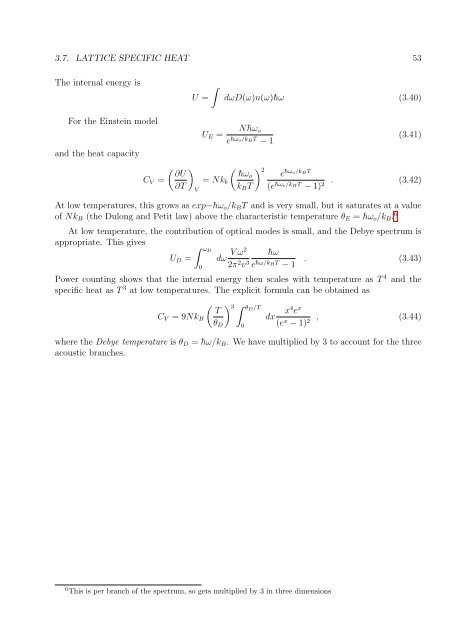Set of supplementary notes.
Set of supplementary notes.
Set of supplementary notes.
Create successful ePaper yourself
Turn your PDF publications into a flip-book with our unique Google optimized e-Paper software.
3.7. LATTICE SPECIFIC HEAT 53<br />
The internal energy is<br />
∫<br />
U =<br />
dωD(ω)n(ω)h¯ω (3.40)<br />
For the Einstein model<br />
and the heat capacity<br />
C V =<br />
( ) ∂U<br />
∂T<br />
V<br />
U E =<br />
Nh¯ω o<br />
e h¯ωo/k BT<br />
− 1<br />
(3.41)<br />
( ) 2 h¯ωo e h¯ωo/k BT<br />
= Nk b<br />
k B T (e h¯ωo/k BT<br />
− 1) . (3.42)<br />
2<br />
At low temperatures, this grows as exp−h¯ω o /k B T and is very small, but it saturates at a value<br />
<strong>of</strong> Nk B (the Dulong and Petit law) above the characteristic temperature θ E = h¯ω o /k B . 6<br />
At low temperature, the contribution <strong>of</strong> optical modes is small, and the Debye spectrum is<br />
appropriate. This gives<br />
∫ ωD<br />
U D = dω V ω2 h¯ω<br />
2π 2 v 3 e h¯ω/k BT<br />
− 1 . (3.43)<br />
0<br />
Power counting shows that the internal energy then scales with temperature as T 4 and the<br />
specific heat as T 3 at low temperatures. The explicit formula can be obtained as<br />
C V = 9Nk B<br />
( T<br />
θ D<br />
) 3 ∫ θD /T<br />
0<br />
x4 e x<br />
dx<br />
(e x − 1) , (3.44)<br />
2<br />
where the Debye temperature is θ D = h¯ω/k B . We have multiplied by 3 to account for the three<br />
acoustic branches.<br />
6 This is per branch <strong>of</strong> the spectrum, so gets multiplied by 3 in three dimensions








